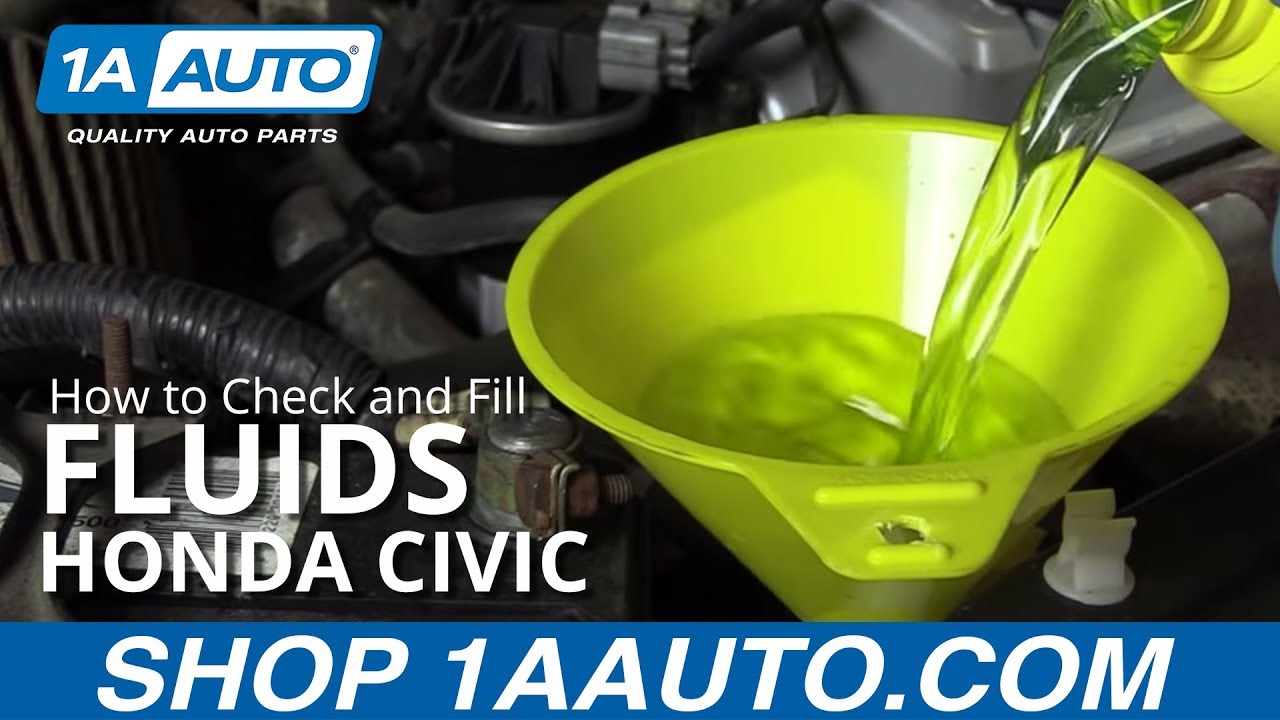
How to Check and Fill Fluids 2001-05 Honda Civic 1-7L 4-cyl
Created on: 2016-06-03
Watch this helpful 1A Auto video on how to check and fill the fluids on your 01-05 Honda Civic 1.7L 4-cyl.
-
step 1 :Checking the Power Steering Fluid
- Check the full line
-
step 2 :Checking the Engine Oil
- With the engine off for a few seconds, remove the dipstick
- Wipe the dipstick off
- Dip the dipstick back in
- Remove the dipstick
- Make sure you level meets the second dot
-
step 3 :Checking the Engine Coolant
- With the engine cold, release the radiator cap
- See how much coolant is in the tube
- Check the Min and Max fill lines on the coolant tank
-
step 4 :Checking the Brake Fluid
- Remove the cap from the master cylinder
- The brake fluid should look like green tea
-
step 5 :Transmission Fluid
- Start the engine
- Make sure the engine has reached operation temp
- Drive the car for a bit to heat up the fluid
- Find level ground
- Remove the transmission dipstick
- Make sure the fluid level is between the two hash marks
Brought to you by 1AAuto.com, your source for quality replacement parts and the best service on the Internet.
Hi, I'm Mike from 1A Auto. I hope this how-to video helps you out, and next time you need parts for your vehicle, think of 1AAuto.com. Thanks.
In this video, we're going to show you how to check and fill fluids. This is a 2003 Honda Civic with the 1.7-Liter 4-cylinder. This is pretty much the same for the 2001 to 2005 Civics with this engine, as well as various other Honda vehicles. Power steering fluid, which we check on the marks. Ours is a little low. Use Honda and Acura-specific power steering fluid. Bring it back up to the full line.
This is the color your fluid should be in the reservoir. Make sure that it isn't dark or burnt smelling. These things can indicate pump failures and other kinds of wear in the system. When the vehicle's off and has been sitting for at least a few seconds to allow the oil to drain down, remove your engine oil dip stick. Wipe it off. Put it all the way back in.
When checking your oil level, these two dots indicate one quart. As you can see, ours is right at the top dot, nice and full. Halfway between would mean you need a half a quart. This dot would mean a quart. Anything below, you'll have to add a quart at a time and inspect your dip stick each time. You can't judge the condition of the fluid off-color with oil because it becomes very dark, very quick. Make sure that you monitor the mileage for your oil change intervals.
With the engine cold, carefully release the radiator cap. Make sure there's no pressure, sure that you have plenty of coolant in there. Our radiator's full. Here on the expansion tank, we have our minimum and our maximum fill lines. As you can see, ours is empty from when we changed our radiator. We'll remove the cap, use a funnel to bring it up to that full line with 50/50 diluted coolant. Remove the cap on your master cylinder. Inspect the condition of the brake fluid. It should look like green today. Any kind of milkiness or dark discolorations indicate that there's some kind of contamination to the brake fluid, and it should be flushed and refilled immediately.
The minimum and maximum marks are on the side. As long as it is between there, you're okay. You don't want to top it up if it's between the min and max because, as your brake pads wear down, more fluid is needed to fill the void behind the calipers and a little bit of fluid sucks down. As long as there's fluid in the cylinder and above the minimum line, only top off after replacing your brake pads.
Start the vehicle. You'll want to make sure that your engine has reached operating temperature and that you've driven the car a little bit to allow the transmission fluid to circulate properly. Remove your transmission dip stick, wipe it off, reinstall, and check your fluid level.
The fluid level should be between these hash marks. Otherwise, you'll want to install a funnel where the dip stick goes and top off your fluid.
Thanks for tuning in. We hope this video helped you out. Next time you need parts for your car, please visit 1AAuto.com. Also check out our other helpful how-to and diagnosis videos.

Tricks to Remove Sticky Gunk How to Wash Your Car Repair Scratches
This video gives some tips to removing sticky stuff from your car without scrubbing, which can damage the paint.
